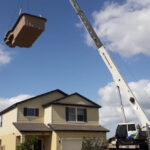For many people, having a new pool at home is a dream come true. In some cases, it’s almost like buying your first brand new car — a cause for pride and celebration!
But, as in the example of the car, whoever installs a swimming pool needs to know that, from now on, this wonderful leisure space will demand constant attention and care.
After all, the new pool is much more than a simple tank full of water and, precisely because of this, its maintenance requires a series of actions that range from chemical balance adjustments to understanding the operation of the equipment and the engine room.
So, if you’re one of those “first-time sailors”, don’t worry, because with today’s article we’ll help you kick-start this new phase!
Understanding the chemistry of your new pool
The first thing you need to know about your new pool is that the frequency and efficiency of chemical treatment is directly related to the time the care routine will take.
That’s because the more careless your commitment to the periodicity in the application of solutions such as chlorine, algaecide, soda and other stabilizers, the faster the water will turn greenish and smelly — and the longer the recovery process will take.
In another article here on the blog, we have already explained how to treat the pool, stressing that the use of these chemicals serves precisely to eliminate microorganisms and impurities from the water, preventing the formation of algae and the concentration of oil and other residues. Just click here to check it out!
And we want to point out that there is indeed a methodology for this entire process, in which each product must be applied in a correct order and in specific quantities. Not to mention that, in addition, executing this routine successfully also requires the use of the tools and equipment suitable for this function.
So, here’s a tip: get information about issues such as the chemical balance of the water, the ideal frequency of application for each type of product, how they act in synergy to guarantee a clean and healthy pool, how to check these levels and know the right time to put the pump into action.
Mastering the features and care of the engine room
And speaking of motor pumps, we have another fundamental warning for those who have never “piloted” the engine room of a swimming pool before: consult a specialist and master the controls and settings before putting the engine to work!
Keep in mind that this is where some of the most important processes take place, such as filtration, aspiration and water circulation.
It is the filter, for example, that ensures that all the dirt that goes to the bottom of the pool is removed, ensuring clean and healthy water for bathers. Oh, and it only works thanks to her support, the motor pump, which is responsible for sucking the water and directing it through the filter and then back to the pool.
By better understanding how this entire workflow works, it also becomes easier to understand why the purification routine includes tasks such as cleaning the pre-filter, circulating the water for long hours or, eventually, changing the filter sand.
Making the right choice of products
We’ve already said that the application of chemicals is what will guarantee the efficiency in cleaning your new pool, right? But don’t forget that as important as respecting the application schedule is choosing and using certified quality solutions at the time of treatment!
The use of inferior quality products — or the substitution of non-recommended chemical components — acts as a silent and discreet enemy that, in the long run, can cause heavy damage to the pocket of those who have a swimming pool at home, compromising the integrity of both the structures. external as well as the items in the engine room.
The reason is that despite having simple and resistant mechanics, pool motors are susceptible to the type of product that is placed in the water. A bad quality algaecide, for example, can cause the sand in the filter to accumulate debris, losing its effectiveness.
In addition, products such as aluminum sulfate and chlorine, when destabilized, can cause damage to the plumbing and pump.
Therefore, it is important that the owner of the new pool already starts this routine by choosing properly tested solutions with proven efficiency, ensuring more longevity for this space and, of course, health for bathers!
Check other blogposts here:

Exclusive Pools now offers EcoFinish pool coating
ecofinish pool coating

The ultimate DIY guide to installing your fiberglass pool:
DIY Fiberglass pool – Installing a fiberglass pool in your backyard is an exciting project that can transform your outdoor space into a personal oasis.

Building your dream pool: The complete guide to DIY Fiberglass pool kits.
DIY Fiberglass pool – Have you ever imagined turning your backyard into a luxurious oasis, complete with your own sparkling pool?The idea of having a

DIY Fiberglass Pools: As aeasy guide to building your own
DIY Fiberglass Pools – Building your own pool can seems like a hard task, but with the right materials and guidance, it can also be


